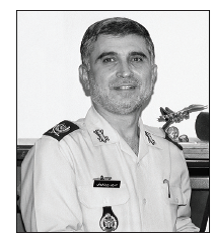Air Raid to Al-Waleed (3)
The Story of Demolishing Fighters and the Equipment in Al-Waleed Triple Military Bases Known as H-3
2016-1-11
Air Raid to Al-Waleed (H-3)
The Story of Demolishing Fighters and the Equipment in Al-Waleed Triple Military Bases Known as H-3
By: Brigadier General Ahmad Mehrnia
Tehran, Sooreh Mehr Publications Company
2010 (Persian Version)
Translated by: Zahra Hosseinian

Second Brigadier General Pilot Hossein Cheetforoushan, president of Theoretical Research and Strategic Studies Center of IRIAF
Foreword of chief of IRIAF Theoretical Research and Strategic Studies Center
On a memorable Thursday morning and in the vicissitudes of an unequal and imposed battle, eight Phantom bombers, guided by experienced and determined pilots, flew about 1700 km, entered into Iraq, attacked the H-3 bases - called ‘Al-Waleed’ - and created one of the masterpieces of air operations in the world. At the backstage of this operation, more than 50 sorts of aircrafts, such as fuel tanker, different kinds of fighter plane and other combat support flying along with a large number of flight and non-flight personnel, played a role to achieve such a success.
Sixteen strong-willed men began nearly five hours flight when the arrangement of light and heavy anti-aircraft systems of enemy awaited them in their trajectory, and enemy’s fighter planes had covered the sky of zone.
The turning-point of this significant operation should be sought in the bright face and beautiful smile of the late Imam Khomeini, who appreciated the air forces, boldness of its resourceful commander, courage of pilots and dedicated employees, on behalf of great and noble nation of Iran by expression of satisfaction with the result.
However, after nearly three decades of this glorious event, the dimensions of the long-range invasion yet haven’t scrutinized enough to be worthy, and making a movie and writing one or two one-dimensional work could not portray the greatness and importance of the longest overseas operation of IRIAF in the minds.
With knowledge of decision and effort of Amir second Brigadier General pilot Ahmad Mehrnia for writing mentioned operation, Theoretical Research and Strategic Studies Center of IRIAF, which seeks itself to revitalize education of war and documentation of Air Force operations, used its efforts so that by creating this unique work, he could transmit part of heritage of eight years continuous presence of IRIAF personnel at the scene of the battle to the future generations.
For characteristics of the author, suffice to say that he has a special ability to communicate with his readers; and on the other hand, with superintendence in the aviation field, he is able to analyze and discover hidden details of such issues. Accordingly, it seems that this book could depict this mission from various angles in a new way.
For attention of some of concerned responsible in the field of publishing Sacred Defense values and relationships with competent institutions (internal and external organization) to address the hidden aspects of air combat operations and introduce unspoken of Sacred Defense, Theoretical research and Strategic Studies Center of IRIAF for fulfillment of this great goal is also determined to continue this purposeful path to provide an exploration ground for other valuable and effective operation of air force, towards development of war education and in order to analyze events and developing military ideas of designers and Sacred Defense heroes.
I hope that this small steps then to be worthy helpful in extraction and explanation of air forces’ future offensive and defensive strategies for dealing with potential threats.
Second Brigadier general, Staff pilot
Hossein Cheetforoushan
To be continued…
Number of Visits: 5225








The latest
Most visited
- Third Regiment: Memoirs of an Iraqi Prisoner of War Doctor – 8
- 100 Questions/7
- The 372nd Night of Memoires– Part 2
- The Role of Objects in Oral Narrative
- 100 Questions/ 8
- Pak-Setan (Clean-Seeker)
- Third Regiment: Memoirs of an Iraqi Prisoner of War Doctor – 9
- The Relationship between “Religious Jurisprudence” and “Oral History”
Challenges of Interviewing in Oral History
After years of studying the theoretical foundations of oral history, conducting numerous interviews and going through their post-interview stages, as well as reading the available body of oral history literature, I was eventually given the opportunity to evaluate the edited versions of dozens of oral history projects.Comparing the Narratives of Commanders and Ordinary Combatants in the Sacred Defense
An Analysis of Functions and ConsequencesThe experience of the Sacred Defense cannot be comprehended merely through statistics or official reports; what truly endures from war are the narratives of those who stood upon its frontlines. These narratives, however, vary significantly depending on one’s position, responsibilities, and lived experience.
Unveiling of the book "Oral History: What and Why"
The First report: Alireza KamariAccording to the Oral History website, the unveiling ceremony of the book "Oral History: What and Why" by Hamid Qazvini was held on Sunday evening, November 24, 1404, in the presence of experts in the field of oral history in the Salman Farsi Hall of the Arts Center.


